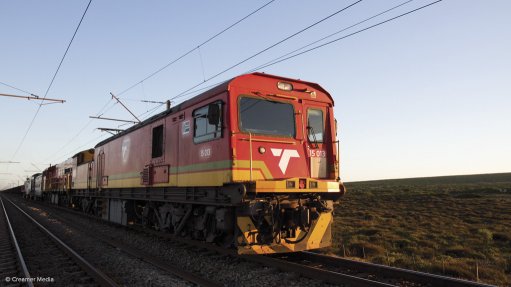
Photo by: Creamer Media
The bottlenecks in South Africa’s export corridors – caused in large part by State-owned logistics company Transnet’s inability to provide sufficient capacity – will likely undermine any opportunities that could arise from commodity supply shortages and higher prices as more sanctions are implemented against Russia, financial services provider Sanlam Investments equity analyst and fund manager Andrew Snowdowne told Engineering News on March 4.
Following Russia’s invasion of Ukraine on February 24, sanctions have now been imposed on Russia by the European Union, the UK, the US, Canada, Australia and Japan, while certification of the Nord Stream 2 pipeline project has been suspended by Germany.
Prior to the invasion, Russia provided more than 10% of the global supply of palladium, natural gas, gold, oil and coal. Much of this will now need to be sourced elsewhere, with South Africa potentially in a position to fill the gap if it could only get more commodities, specifically thermal coal, out of the country.
“South Africa, with its significant exposure to bulk commodities such as coal, iron ore and manganese, is not in a strong position to take full advantage of sharply rising prices owing to Transnet’s infrastructure problems and inefficiencies. It’s a very sad situation,” Snowdowne said.
He noted that, for now, there was much speculation and little certainty owing to the rapidly changing situation in Ukraine. Although supply chains appeared to be relatively unaffected for the time being, he said it was definitely not “business as usual”.
Snowdowne explained that geopolitical events typically impact commodity supply more than demand.
Sanctions are not currently targeting commodity flows and, in Sanlam’s view, are unlikely to do so directly, owing to the current power situation in Europe, the broader inflation backdrop and the market dislocation that followed sanctions on Russian aluminium producer Rusal in 2018.
Nevertheless, Snowdowne said there was the potential for exports from Russia to be disrupted by either indirect effects or by Russia’s own choice to restrict exports.
He said that recent history of geopolitical events suggested that the effects on markets were unlikely to be persistent because they did not change the underlying economic realities. Snowdowne said this may well be the case again, but the potential for a significant negative commodities supply shock created the risk that “this time it’s different”, and that prices might continue to rise sharply.
“This should of course be very bullish for commodity prices, against a backdrop of broadly tight supply-demand balances. However, one should be cognisant that the follow-on impact of dramatic cost-push price inflation, is demand destruction,” he noted.
Snowdowne said a marked intensification of an upward trend in commodity prices, which had occurred over the past six weeks, had been reinforced by investors searching for inflationary hedges.
“When played out against the background of production disruptions owing to Covid-19, supply chain dislocations and limited supply growth, the result has been a powerful uplift for commodities as an asset class,” he said.
POSITIVE DRIVERS
Beyond geopolitical factors, Snowdowne noted that there were several positive drivers for commodities.
The first of these was general under-investment. He said that a period of substantial over-investment and poor capital allocation between 2007 and 2011 was followed by lower capital expenditure and increased shareholder distributions.
Moreover, the cost of capital is now also higher owing to environmental, social and governance concerns.
The second driver was demand recovery post Covid-19.
“We expect the impact of an end of destocking and significant restock to drive demand for many commodities to levels higher than many expect – most notably in the platinum group metals as the semi-conductor shortage in the automotive sector continues to normalise,” Snowdowne said.
Thirdly, commodities have historically been an effective hedge against inflation, although many surveys suggest investor allocation to commodities is still well below historical averages.
Finally, decarbonisation efforts are leading to a tighter supply and demand environment.
Snowdowne said the energy transition was creating significant new demand for aluminium, copper, silicon, silver, steel, zinc and iridium, besides others.
Moreover, Snowdowne said the energy transition was creating significant uncertainty over the outlook for commodities such as oil, gas and thermal coal, thereby impacting on investment in these commodities and constraining supply.
“We are all moving down the path towards decarbonisation, which is the right thing to do, but there is still going to be a need for fundamental commodities such as oil, gas, and coal for an extended period.
However, a mass lack of incentive to invest in these commodities will lead to a supply and demand disconnect,” he explained.
He concluded by reiterating that South Africa would not be in a position to meaningfully take advantage of the upsides in the current market until Transnet is able to resolve the bottlenecks in its network.